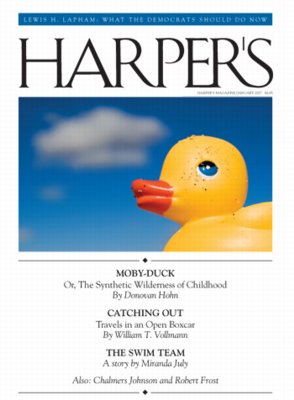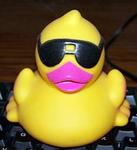
Still not quite sure what it was about, but with a giant rubber duck looming on the cover, there's no way I wasn't reading "Moby Duck: On the Synthetic Wilderness of Childhood," Donovan Hohn's 150,000-word [+/-] article in the January issue of Harper's Magazine.
Hohn goes long and deep by tracking down--literally--a shipping containerful of Baby Trend First Years bath toys that washed overboard somewhere in the Pacific in 1996 1992, and which oceanographers, climate scientists, and dedicated flotsam hunters have been logging ever since. There were equal parts ducks, turtles, and frogs in the container, but news stories only ever mention the ducks.
And so Hohn drifts into a history of modern childhood and the rise of the baby industrial complex to see why and when the duck landed on our collective psychic shore, where it was worshipped as a Great Yellow God. Ernie and the Sesame Street Generation get a mention, and there are more lyrical metaphors on a single page than there are six-pack rings in a dead albatross's belly.
 But Hohn boy gets major props in the gonzo essayist department, at least, for managing to make it back to Brooklyn from the Aleutian Islands or some such place a week before his own child was born [?!] I hope I don't spoil the ending by asking if this whole article is actually about how one guy comes to terms with impending fatherhood. I'd go back and re-read it for clues, but frankly, I didn't have the time to spare the first time around.
But Hohn boy gets major props in the gonzo essayist department, at least, for managing to make it back to Brooklyn from the Aleutian Islands or some such place a week before his own child was born [?!] I hope I don't spoil the ending by asking if this whole article is actually about how one guy comes to terms with impending fatherhood. I'd go back and re-read it for clues, but frankly, I didn't have the time to spare the first time around.
Hohn also gets full credit for bringing to light [to me, anyway] the Logan's Run-like predictions of V.E. Yarsley and E.G. Couzens, two British chemists in 1941, who, as Hohn put it, "prophesied with surprising accuracy and quaintly utopian innocence what middle-class childhood in the 1970s would be like. 'Let us try to imagine a dweller in the "Plastic Age,"' they wrote in the British magazine Science Digest:
Uh, thanks?This creature of our imagination, this "Plastic Man," will come into a world of colour and bright shining surfaces, where childish hands find nothing to break, no sharp edges or corners to cut or graze, no crevices to harbour dirt or germs, because, being a child his parents will see to it that he is surrounded on every side by this touch, safe, clean material which human thought has created. The walls of his nursery, all articles of his bath and certain other necessities of his small life, all his toys, his cot, the moulded perambualtor in which his takes tha air, the teething ring he bites, the unbreakable bottle he feeds from...allwill be plastic, brightly self-coloured and patterned with every design likely to please his childish mind.
"Moby Duck: On the Synthetic Wilderness of Childhood" by Donovan Hohn, Harpers, Jan. 2007 [harpers.org, not online, alas]

Ummm, 150K words, thanks for the wonderful abstract and I'll call it a day there. Here's the link about the ducks and it was a container from my old company that started this mess.
http://www.csmonitor.com/2003/0731/p01s04-woeu.html
that's the one. And I may be off by 140k words or so, -ed.]
I suppose that in 1941 they weren't as worried about the effects of so many decaying plastics around children and they chemicals that they would leach into kids' bodies. "Polystyrene, polypropylene, and polyvinyl chloride, oh my!" as Anthromama recently commented when I recently posted a video showing 3B eating off a plastic spoon.